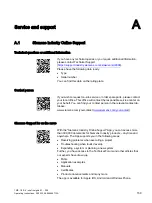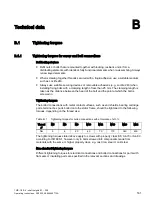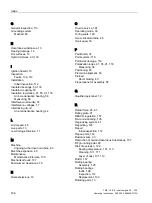
1MB..1/2/3/4 - shaft heights 63 ... 355
Operating Instructions, 06/2020, A5E44455710A
161
Technical data
B
B.1
Tightening torques
B.1.1
Tightening torques for screw and bolt connections
Bolt locking devices
●
Refit nuts or bolts that are mounted together with locking, resilient, and/or force-
distributing elements with identical, fully-functional elements when re-assembling. Always
renew keyed elements.
●
When screwing together threads secured with a liquid adhesive, use a suitable medium
such as Loctite 243.
●
Always use suitable securing devices or removable adhesives (e.g., Loctite 243) when
installing fixing bolts with a clamping length of less than 25 mm. The clamping length is
taken as the distance between the head of the bolt and the point at which the bolt is
screwed in.
Tightening torques
The bolted connections with metal contact surfaces, such as end shields, bearing cartridge
parts, terminal box parts bolted onto the stator frame, should be tightened to the following
torques, depending on the thread size:
Table B- 1
Tightening torques for bolted connections with a tolerance of ±10 %.
Thread
∅
M5
M6
M8
M10
M12
M16
M20
M24
Nm
5
8
20
40
70
170
340
600
The tightening torques stated above apply to screws with property class 8.8, A4-70 or A4-80
according to ISO 898-1, however only to bolts screwed into components made from
materials with the same or higher property class, e.g. cast iron, steel or cast steel.
Non-standard tightening torques
Different tightening torques for electrical connections and bolted connections for parts with
flat seals or insulating parts are specified in the relevant sections and drawings.








































